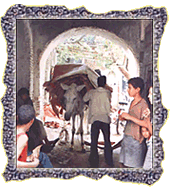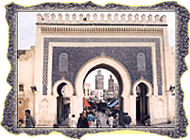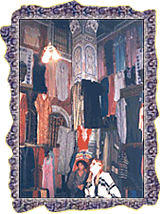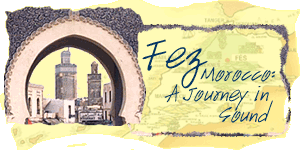 |
 |
 |
|
|||
|
Fez, Morocco: A Journey in Sound For a long time, I've wanted to go to Morocco to make recordings. There are echoes there of sounds that whisper old secrets, and I wanted to hear them. The best place to listen, I was told, is in the city of Fez, one of the oldest continuously inhabited cities in the world. Fez is really three cities, the first a modern European-style metropolis, the second, Fez El-Jadid or "New Fez", dates from the 13th century; and "Old Fez", Fez-El Bali, goes back to the 9th century. And that's where we are now. 
Picture an ancient, walled city with buildings made of stone, mortar and wood. There are palaces with elaborate tiled entryways. There are ramparts, balconies, courtyards, and apartments, all in the sand-gray hues that intimate there is a desert not too far away. The cobblestone streets of Old Fez are a maze of alleyways and tunnels, too narrow for a car to get through. So the traffic is mostly people and donkeys. "Balek" is the donkey driver's equivalent of a car horn, and it means "out of the way". Two hundred twenty-five thousand people inhabit the Old City of Fez, in an area roughly four and a half square miles. For the folks who live here, it's one enormous extended family. For a child growing up here, the alleyways of the old city are one extended playground. Amidst the bustle of activity of the city, always in motion, like a giant human hive, there are moments when the sounds themselves will slow you right down. In a tunnel passageway, with children playing nearby, and tourists and tradespeople walking past, an old man intones praises to Allah. Morocco is an Islamic country, and in Fez's medina, that's another name for the old city, there are literally hundreds of mosques. Five times a day you can hear the call to prayer throughout the city, but probably the best place to hear it is from a rooftop, where it's just you, the pigeons and a timeless sound. 
Non-Muslims are not allowed inside mosques, but it is possible to gain entrance to a Koranic School. Men who live and work in this part of the medina come here to pray, but before they do, they remove their shoes and wash their feet, hands and face at the fountain in the school's courtyard. As a flock of birds circles overhead, the Imam begins his prayer, facing towards Mecca, and a row of a dozen men standing shoulder-to-shoulder join him. Outside the courtyard of the Koranic school, the life of the medina hums right along and it's easy to be drawn through the alleyways and tunnels from one sound to another. That's the "gerrab", who carries a goatskin full of water and dispenses it in a brass cup to anyone who requires a drink. Along with the bell, his signature sound, the gerrab wears a broad rimmed hat, fringed with tassels, and a costume bedecked with tiny mirrors. And for a few "dirham", the Moroccan currency, he'll let you take his picture. On the streets of the Old City, there's a mixture of western and traditional dress. Men still do wear fezzes in Fez, but you're more likely to see them wearing a cloth or embroidered skullcap. Women are often veiled and wearing long caftans. The passageways of the medina are lined with stores and stalls selling a mix of modern and more traditional goods, foods of every description, but most especially dates and olives, spices, clothing, hardware, dry goods, school supplies, electrical supplies, video games and cassettes. There are boom boxes everywhere here and they compete for a niche in the raucous soundscape. 
In the ecology of the marketplace, tourists are both predator and prey, taking photographs at every opportunity of a people who, for the most part, really don't want to have their picture taken. In turn, the busloads of tourists who make their rounds through the medina are hit on by hawkers, stall-keepers and would-be guides. The sounds of bargaining ripple through the medina, and the merchants of Fez are master salesmen. There are subtler sonic delights in the old city, somewhat off the beaten pathways, like the sound of grain being sifted before it's ground into flour. Or the noise made by a little hand motor used to twist the cotton thread for making jalabas, the traditional men's outer garment. Fez has a rich tradition of craftsmanship. Whole sections of the old city belong to artisans who work in brass, stone, textiles, wood and leather. The Palace Safarine is a bustling courtyard of stalls and workshops. Stone chiselers patiently ply their trade, nearby men who hammer intricate designs onto brass trays. And sometimes it seems as though the rhythm of one is picked up by another. And then suddenly it's dusk, and the trail of sounds expands and intersperses throughout the Old City. There's magic in the air, and what better place to hear it than at the "Bab Bou Jeloud," the Blue Gate, the place where most people enter and leave the medina. In the throngs of humanity that parade by, and in those at the cafes that sit and watch them, there's an air of expectancy, echoed by the birds who roost here as if in the midst of all this apparent chaos, there's a last minute chance to make some sense of it all. And for a fleeting moment, the music that is hidden in all sounds reappears, and once again you hear it. From Fez, Morocco, I'm Jim Metzner for The Savvy Traveler.
|
 | American Public Media Home | Search | How to Listen ©2004 American Public Media | Terms of Use | Privacy Policy |
